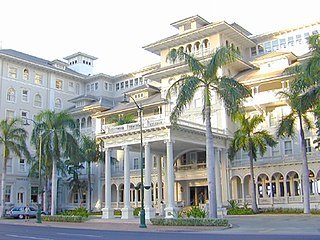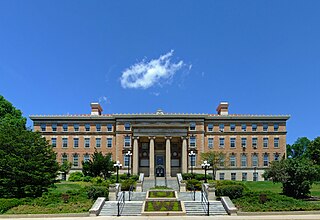
The ʻIolani Palace was the royal residence of the rulers of the Kingdom of Hawaii beginning with Kamehameha III under the Kamehameha Dynasty (1845) and ending with Queen Liliʻuokalani (1893) under the Kalākaua Dynasty, founded by her brother, King David Kalākaua. It is located in the capitol district of downtown Honolulu in the U.S. state of Hawaiʻi. It is now a National Historic Landmark listed on the National Register of Historic Places. After the monarchy was overthrown in 1893, the building was used as the capitol building for the Provisional Government, Republic, Territory, and State of Hawaiʻi until 1969. The palace was restored and opened to the public as a museum in 1978. The ʻIolani Palace is the only royal palace on US soil.

Hawaiian architecture is a distinctive architectural style developed and employed primarily in the Hawaiian Islands, buildings and various other structures indicative of the people of Hawaiʻi and the environment and culture in which they live. Though based on imported Western styles, unique Hawaiian traits make Hawaiian architecture stand alone against other styles. Hawaiian architecture reflects the history of the islands from antiquity through the kingdom era, from its territorial years to statehood and beyond.

ʻIolani Barracks, or hale koa in Hawaiian, was built in 1870, designed by the architect Theodore Heuck, under the direction of King Lot Kapuaiwa. Located directly adjacent to ʻIolani Palace in downtown Honolulu, it housed about 80 members of the monarch's Royal Guard until the overthrow of the Monarchy in 1893. It was added to the National Register of Historic Places in 1978 as part of the Hawaii Capital Historic District.

The Hawaii Theatre is a historic 1922 theatre in downtown Honolulu, Hawaii, located at 1130 Bethel Street, between Hotel and Pauahi Streets, on the edge of Chinatown. It is listed on the State and National Register of Historic Places.

Saint Patrick Catholic Church, Honolulu is a parish in the Kaimuki district, in the East Honolulu Vicariate of the Roman Catholic Diocese of Honolulu, Hawaii. The church was consecrated under the title of St. Patrick, Bishop of Armagh. Its Romanesque architecture, as well as its fine ecclesiastical appointments such as stained glass windows and pipe organ, are attractive to prospective couples seeking nuptial rites.
La Pietra: Hawaii School for Girls, also referred to as La Pietra or Hawaii School for Girls, is a private school for girls in grades 6–12 located in Honolulu, Hawaii. Founded in 1964 by Lorraine Cooke, it moved to the current La Pietra campus in 1969. Barbara Cox Anthony chaired the school's board of trustees until her death in 2007. The school is at the foot of Diamond Head. The main building was designed by Chicago architect, David Adler and was modeled after an Italian villa in Florence, Italy of the same name.

The Melchers Building is a historic commercial building in Downtown Honolulu, Hawaii. Located at 51 Merchant Street, it is the oldest commercial building in Honolulu. Designed in the Classical Revival style by an unknown architect, it was constructed in 1854 of white coral blocks. The original structure's qualities are no longer visible beneath outer layers of stucco and paint.

The Hawaiian Mission Houses Historic Site and Archives Honolulu, Hawaii, was established in 1920 by the Hawaiian Mission Children's Society, a private, non-profit organization and genealogical society, on the 100th anniversary of the arrival of the first Christian missionaries in Hawaiʻi. In 1962, the Mission Houses, together with Kawaiahaʻo Church, both built by those early missionaries, were designated a U.S. National Historic Landmark (NHL) under the combined name Kawaiahao Church and Mission Houses. In 1966 all the NHLs were included in the National Register of Historic Places.

Vladimir ‘Val’ Nicholas Ossipoff was an American architect best known for his works in the state of Hawai'i.

Thomas Charles Byde Rooke was an English physician who married into the royal family of the Kingdom of Hawaii. He built a mansion called the Rooke House in Honolulu that became popular with political and social leaders of the Kingdom.

Kapālama, now often called Pālama, is a neighborhood of Honolulu, Hawaii. It is often combined with the adjacent Kalihi and referred to as a single entity, Kalihi–Pālama.

Oliver Green Traphagen was an American architect who designed many notable buildings in Duluth, Minnesota, during the late 19th century and in the Territory of Hawaii during the early 20th century. Among his most famous landmarks are the Oliver G. Traphagen House in Duluth, called the Redstone, and the Moana Hotel in Honolulu, both of which are on the National Register of Historic Places, as are several other buildings he designed.
Charles William “C.W.” Dickey was an American architect famous for developing a distinctive style of Hawaiian architecture. He was known not only for designing some of the most famous buildings in Hawaiʻi—such as the Alexander & Baldwin Building, Halekulani Hotel, Kamehameha Schools campus buildings—but also for influencing a cadre of notable successors, including Hart Wood, Cyril Lemmon, Douglas Freeth, Roy Kelley, and Vladimir Ossipoff.

The Merchant Street Historic District in Honolulu, Hawaii, was the city's earliest commercial center.
Louis E. Davis was an American architect who designed homes and public buildings in Honolulu, Hawaii. During the 1920s, he was involved in laying out the new King Street campus of President William McKinley High School and designing its buildings in a Spanish Colonial Revival style. He employed a similar style in designing the 1931 Honolulu Police Station on Merchant Street, which harmonized well with that of the new city hall, Honolulu Hale. Both the old McKinley campus quadrangle and the Merchant Street Historic District are on the National Register of Historic Places.

The Honolulu Fire Department (HFD) operates their 44 Fire Stations on the Island of Oahu, and in and around Honolulu. Seven current or former stations are on the National Register of Historic Places, of which five are still in use today as fire stations.

The Oʻahu Cemetery is the resting place of many notable early residents of the Honolulu area. They range from missionaries and politicians to sports pioneers and philosophers. Over time it was expanded to become an area known as the Nuʻuanu Cemetery.

The Chinatown Historic District is a neighborhood of Honolulu, Hawaii, known for its Chinese American community. It is one of the oldest Chinatowns in the United States.

Hilo Masonic Lodge Hall, also known as the Bishop Trust Building, is a historic structure in Hilo, Hawaii. Constructed between 1908 and 1910, it was designed to house commercial space on the ground floor and a meeting hall for a local Masonic lodge on the second floor. The Masons stayed until around 1985.

Agriculture Hall is a Beaux Arts-style building on the campus of the University of Wisconsin–Madison built in 1903. In 1985 it was added to the National Register of Historic Places for its architecture and because it housed the first Department of Agricultural Economics in the U.S. and the first department of genetics.

















